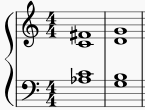 One problem with the Blogging A-to-Z challenge becomes obvious when you try to cover a field like music theory that has concepts building on other concepts. You wind up posting things out of order.
One problem with the Blogging A-to-Z challenge becomes obvious when you try to cover a field like music theory that has concepts building on other concepts. You wind up posting things out of order.
Today, for example, I'll cover a somewhat esoteric bit of harmony that I find interesting and difficult, but that the previous four posts could not possibly have prepared anyone for if they have just started studying music theory: augmented sixth chords.
I'm joking that anyone would call them "ethic" sixth chords, but they do have specific names that apparently have nothing to do with their origins: the Italian, French, and German sixths.
All three flavors have an augmented sixth within them that resolves chromatically to a perfect octave. Generally, they stand in for V7 of V chords, and drive to half-cadences which can then resolve normally. Plus, they create a really cool tension in a harmonic progression, but like saffron or truffle, composers have used them sparingly.
The Italian variety is the simplest, functioning as a iv chord:

The French sixth adds a Romantic sound and functions more as ii/V:

And the German sixth really lays it on, so much that voice leading rules demand it usually resolve in two steps. It works as a V7 chord and can resolve to V or I:

The University of Puget Sound has a wonderful page of examples in real life.